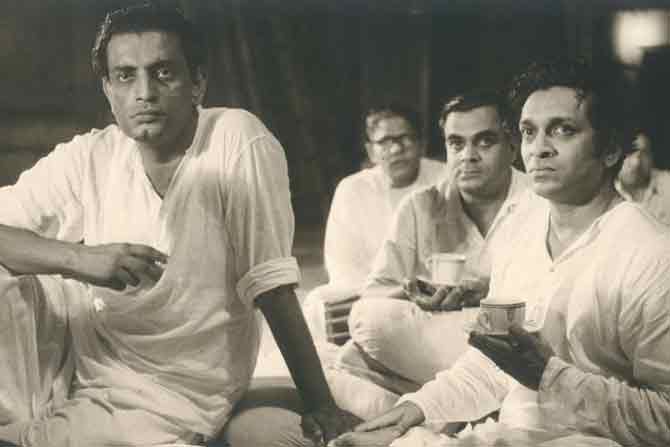"In his second tryst with Pandit Ravi Shankars story, biographer Oliver Craske delves into the legendary sitarists life to understand what influenced his music-making "

Pandit Ravi Shankar plays his Kanai Lal sitar in the 1940s. Pic courtesy /Shankar family
Writer Oliver Craske might as well call himself the chosen one. Penning sitar maestro Pandit Ravi Shankar's biography wasn't something he saw himself doing, especially since he had collaborated on Raga Mala, the second autobiography by the veteran in the late 1990s. "When I first met him, I was only 23," recalls London-based Craske. "My role was to assist him with the book. But I spent a lot of time with him, sitting down and going through the drafts and manuscripts. Occasionally, he'd toss in a comment like, 'Oh! That can come out later.' At that point, Raviji didn't have any fixed plan. But it was as if I was being assigned a role, without asking for it. Like there were seeds being planted for later."
ADVERTISEMENT
Soon after Shankar passed on in 2012, Craske felt the need to write his biography. "I had thought about it for many years [before that], but I slightly resisted the idea, internally. I think I wasn't ready." A conversation with Shankar's second wife and mother to sitarist Anoushka, Sukanya Rajan, who was still in mourning then, made him realise he was destined for the role. "I remember ringing Sukanya up, and decided to ask her what she thought about my idea of writing a biography. It was funny, because, even before I got the words out, she said to me, 'You should write something more about him.' It made absolute sense."
His new book, Indian Sun: The Life and Music of Ravi Shankar (Faber & Faber), which is also the first-ever biography on the veteran, is a result of nearly six years of rigorous research and 130-plus interviews with Shankar's friends, family, musicians, contemporaries, lovers. It's also 650 pages of a life that is as fantastic as it is Bohemian, glowing and illustrious. The kind very few could have claimed to live.

Satyajit Ray (left) and Ravi Shankar (right, aged 36) watch a playback during Shankar’s recording session of music for Ray’s Aparajito in 1956. Pic courtesy/Shankar family
A story has many lives, and Craske was aware of this, before he got started. The biography follows two significant autobiographies by the legendary musician—My Music, My Life (1968) and Raga Mala. "Everyone has their own version of their story, and when you are as famous as Ravi Shankar, you get asked about your life a lot. I think the biographer's job is to dig deeper and understand what motivated the subject [to do what they did]."
Craske says that he was particularly interested in looking at Shankar's time in India in the 1940s and '50s, when he was beginning to make a name for himself in Indian cinema—he rose to fame for his music in Satyajit Ray's Pather Panchali—and the All India Radio. "He is always remembered as the person who took Indian music to the rest of the world, and for his association with the great musicians, [Beatles star George Harrison, John Coltrane, Yehudi Menuhin, among others]. But what people have forgotten is that the reason he went abroad, was because he was already such a big star in India. He had charisma, and experience from his childhood in the West [he had worked with his brother Uday Shankar's dance troupe], and that confidence enabled him to take Indian art to the rest of the world. I became very interested in that period, especially his tryst with AIR. Before he was presenting Indian music to the rest of the world, he was presenting it to India, and in the early age of Indian radio, he was telling Indians, our art forms are wonderful and you should own them."

Shankar performs at 91. Pic courtesy/Michael Collopy
As other-worldly as Shankar's musical career was, so was his personal life. His tempestuous first marriage to Annapurna Devi, the daughter of Shankar's guru and idol Allauddin Khan, under whom he learned the sitar in Maihar for six years, has been under scrutiny on several occasions. For the longest time, Shankar's extra-marital affairs and musical rivalry were said to have been the reason for the marriage falling apart. In the book, Craske writes about Annapurna's preoccupation with her husband's past-sex life that first created tensions in the relationship, which began on a foundation of love. Shankar, on his part, claimed that he had "really controlled myself. And then I found out after a few years that she had an affair with one of my students."
"This is one of the things that he was reluctant to talk about in his lifetime, because she was his guru's daughter. There are certain rules and expectations about what you should be saying. He always felt very tied by that," admits Craske. "It is always very hard to understand what went wrong in someone's marriage. There are usually two different sides of the story. The biographer has to be cautious about that. In this one, there was responsibility on both sides for the marriage breaking down. He obviously had a very complicated private life with lots of relationships [during his lifetime]. But I think it's only when the marriage first fell apart that he started having this complex private life. People always think that he was this ladies' man, but I think they both tried very hard in the marriage. The marriage became a facade in the latter period, and then he went on this sort of three decade-long period, where he had a lot of relationships, some of which endured, like Kamala Chakravarty and Sue Jones [Norah Jones's mother]. And then he eventually married Sukanya, and that was a very happy, satisfying married life. And all his games were over by then," shares the biographer.
Craske has taken great pains to stitch the minutest of details of Shankar's musical oeuvre, as well as his performances across the globe. "My greatest source was the Shankar family's own archives, which Sukanya kept, and which are really excellent, and nobody had been through them in the thorough way that I had. That's where I had picked up a lot of details," he admits.

Oliver Craske. Pic courtesy/Charlotte Knee Photography
His life-long friendship with Harrison, and musical collaborations in the West, which earned him a lot of criticism back home, sometimes causing Shankar deep pain, are also highlighted in the book. "If you look at his music—and I became more convinced about this, as I researched for the biography—he was essentially using other forms at times, like an orchestra, but still making music based on ragas and talas." His collaborations, says the author, were always aimed at giving Indian music a lift. "He was very much like a missionary, showing the world the greatness of the music. He was also about preserving Indian classical music. And that's why he became the hero for the generation."
Catch up on all the latest Mumbai news, crime news, current affairs, and a complete guide from food to things to do and events across Mumbai. Also download the new mid-day Android and iOS apps to get latest updates.
Mid-Day is now on Telegram. Click here to join our channel (@middayinfomedialtd) and stay updated with the latest news
 Subscribe today by clicking the link and stay updated with the latest news!" Click here!
Subscribe today by clicking the link and stay updated with the latest news!" Click here!






